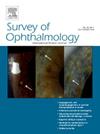Detection of choroidal vascular features in diabetic patients without clinically visible diabetic retinopathy by optical coherence tomography angiography: A systemic review and meta-analysis
IF 5.9
2区 医学
Q1 OPHTHALMOLOGY
引用次数: 0
Abstract
Researchers have explored choroidal features in the eyes of diabetic patients without clinically visible diabetic retinopathy (DM-NoDR) employing optical coherence tomography angiography (OCTA); however, the results are controversial. We systematically searched PubMed, Embase, and Ovid databases for OCTA studies comparing choroidal parameters between DM-NoDR eyes and healthy controls or nonproliferative diabetic retinopathy (NPDR) eyes. Outcomes included choriocapillaris (CC) perfusion density (PD), flow area (FA), and flow deficits (FD). 36 studies were finally included in the quantitative meta-analysis, involving 1908 DM-NoDR eyes, 792 NPDR eyes, and 1391 healthy control eyes. DM-NoDR eyes had significantly lower CC PD in the foveal region (P = 0.0005) and superior parafoveal region (P = 0.003) than healthy control eyes, but no significant difference was found in other parafoveal subregions (P > 0.05). DM-NoDR eyes were also associated with increased CC FD (P < 0.00001) and decreased CC FA (P < 0.0001) in whole OCTA images with a 3 × 3 mm2 field of view (FOV). Compared with all-stage NPDR eyes, DM-NoDR eyes had higher CC PD in the foveal region (P < 0.0001), parafoveal region (P < 0.00001), and the whole OCTA images with a 6 × 6 mm2 FOV (P < 0.00001). Early choroidal microvascular changes may precede clinically visible DR and can be detected early using OCTA in DM-NoDR eyes.
通过光学相干断层血管造影术检测无临床可见糖尿病视网膜病变的糖尿病患者脉络膜血管特征:系统回顾与荟萃分析。
研究人员利用光学相干断层血管造影(OCTA)探索了无临床可见糖尿病视网膜病变(DM-NoDR)的糖尿病患者眼部脉络膜特征;然而,研究结果存在争议。我们系统地检索了 PubMed、Embase 和 Ovid 数据库中比较 DM-NoDR 眼与健康对照组或非增殖性糖尿病视网膜病变 (NPDR) 眼脉络膜参数的 OCTA 研究。结果包括脉络膜睫状体(CC)灌注密度(PD)、血流面积(FA)和血流缺损(FD)。定量荟萃分析最终纳入了36项研究,涉及1908只DM-NoDR眼、792只NPDR眼和1391只健康对照眼。与健康对照眼相比,DM-NoDR眼的眼窝区(P=0.0005)和上视网膜旁区(P=0.003)的CC PD明显较低,但在其他视网膜旁亚区没有发现明显差异(P>0.05)。DM-NoDR眼也与CC FD(P2视场(FOV))增加有关。与所有阶段的 NPDR 眼睛相比,DM-NoDR 眼睛在眼窝区域有更高的 CC PD(P2 视场(P
本文章由计算机程序翻译,如有差异,请以英文原文为准。
求助全文
约1分钟内获得全文
求助全文
来源期刊

Survey of ophthalmology
医学-眼科学
CiteScore
10.30
自引率
2.00%
发文量
138
审稿时长
14.8 weeks
期刊介绍:
Survey of Ophthalmology is a clinically oriented review journal designed to keep ophthalmologists up to date. Comprehensive major review articles, written by experts and stringently refereed, integrate the literature on subjects selected for their clinical importance. Survey also includes feature articles, section reviews, book reviews, and abstracts.
 求助内容:
求助内容: 应助结果提醒方式:
应助结果提醒方式:


